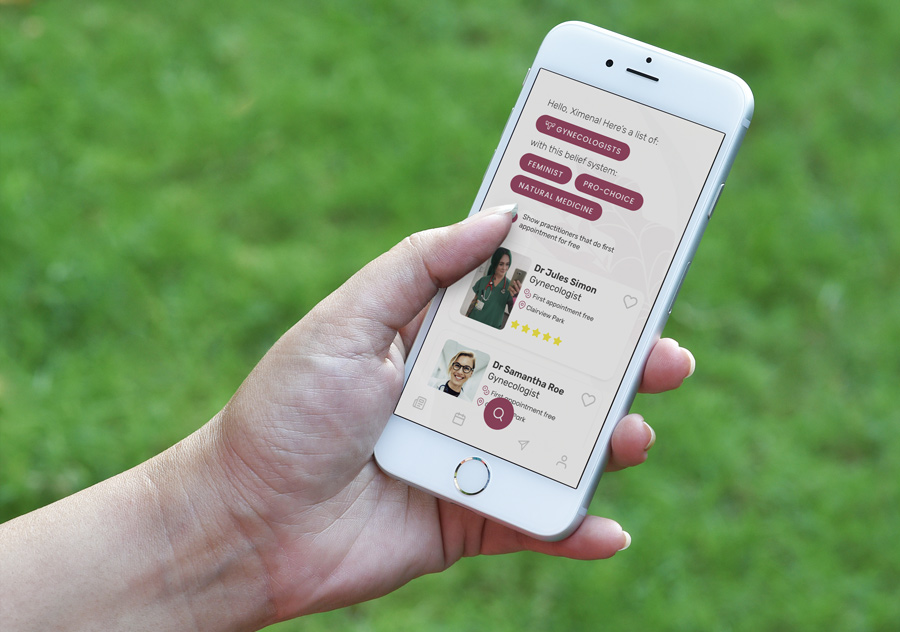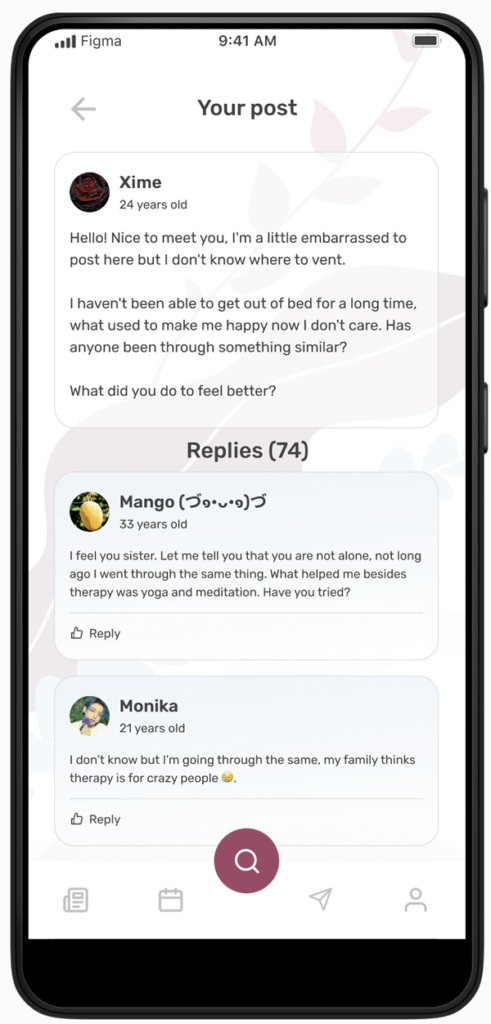
Kupuri
How might we empower women to take charge of their physical and mental well-being in a safe and secure environment?
PUBLISHED
October 2022
TYPE
App
INDUSTRY
Health
01
Roles
- UX Research
- UX Design
- Interaction Design
02
Scenario
In 2021, in Mexico, out of all women aged 15 and over, 70.1% have experienced at least one incident of violence, which can be psychological, economic, patrimonial, physical, sexual or discrimination in at least one area and exercised by any aggressor throughout their life.
Also in Mexico, since 2006 cervical cancer has been the second leading cause of cancer death in women. This is alarming, especially when considering that Mexico is the country with the highest rate of teenage pregnancies in the OECD.
It’s worth mentioning that teenage pregnancies are considered a risk factor for the development of cervical cancer.
Goal
Understanding whether the gender-based violence situation in Mexico affects the way women obtain physical and mental help in order to create a solution that facilitates their access.
03
Primary Research
I conducted interviews with five Mexican women using Zoom, which lasted for 40 minutes. In addition, I created a survey using Google Forms, which received 99 responses.
The primary objectives of this initial investigation were:
- Determine if women receive physical and mental help.
- Uncover reasons why Mexican women don’t seek help from well-being specialists.
- Determine if gender-based violence in the country contributes to not seeking help.
- Understanding barriers to seeking help among Mexican women.
- Identify specific challenges and concerns that prevent women from accessing care.

- Violence does not directly impact women’s access to mental or medical care.
- Women expressed a desire to improve their physical and mental health.
- Rather, lack of knowledge, financial constraints, bad past experiencies and feelings of embarrassment contribute to not seeking care.

04
Secondary Research
I also studied violence against women in Mexico in order to understand the broader social, cultural, and political context in which violence against women occurs, including the root causes and contributing factors.
I created this infographic with the information I obtained.

As part of my secondary research, I explored various apps available in Mexico that aim to support women’s physical and mental health. My goals to research these apps were:
Understand what digital tools and resources are currently available for women in Mexico seeking mental and physical health support.
Evaluate the strengths, weaknesses, and user feedback of existing apps to identify opportunities for improvement and innovation.

05
Persona
Next, based on my research, I created a persona to better understand my user’s fears, goals, and frustrations.

It’s clear that she values finding a therapy option that is personalized and matches her specific beliefs and values. She is also concerned about the cost of therapy and the potential for judgment from others.
06
Customer Journey
After defining my persona, I decided to take a closer look at her customer journey.
I know that Ximena wants to go to therapy, so I wanted to understand her experience from the moment she makes that decision to the day of her therapy session. By understanding her journey, I could create a solution that fits her needs and makes the process as smooth and stress-free as possible.

07
Sketches
I transformed the pain points identified during Ximena’s user journey into opportunities for creating the app’s key features. I utilized the Crazy 8s technique to generate ideas by sketching different possibilities.
I decided that an app would be the best solution because during my research I found out that 77% of internet users in Mexico access the internet through a mobile device.

The logo and name
The name Kupuri, which is derived from the indigenous Huichol language and translates to “soul, spirit, or vital energy”, was chosen for the app as it aligns with the goal of empowering women and aiding in the healing of their spirit.
The logo, a modified vector image, represents this goal through the depiction of a hug, symbolizing support, comfort, and consolation, and a flower, representing love, support, and transitions.

08
Information Architecture
I created an information architecture with a user flow for my app. By mapping out the user flow, I could identify key screens and interactions, design a structure that was intuitive and user-friendly, and organize the app’s content and features in a way that met the needs of its target audience.

09
Wireframes
After that, I created wireframes to flesh out the specific details and interactions for each screen or page. By developing the wireframes after the information architecture, I ensured that the design was aligned with the app’s goals.

11
Prototype
The app was designed with Ximena’s journey in mind, taking into account the pain points she encountered at each step and creating opportunities to address them within the app’s features.
⚠️ Note: The videos should play automatically, if not please press play.
Step 1: Awareness – Ximena recognizes she needs help
Pain Point: Ximena is feeling stressed and depressed, but does not know where to find help.
Solution: Kupuri offers a safe and secure space for women to easily access help with minimal registration requirements. Users only need to provide 3 pieces of information to start searching for specialists who can assist them.
Additionally, the platform includes a verification process, which prompts users to take a photo of themselves holding their ID to confirm their identity as a woman.

Step 2: Discovery – Ximena turns to her inner circle for support
Pain Point: Ximena’s friends don’t go to therapy and she is afraid of being judged.
Solution: Kupuri’s forum allows users to access support and advice anonymously, without the need to use their real name or picture, while still having the option to share their age.
To maintain the platform’s exclusivity to women, users are required to submit a photo of their ID to create an account.
Step 3: Research – Ximena wants to explore her options
Pain Point: Ximena is overwhelmed by the variety of options available and is unsure of what would be best for her.
Solution: Kupuri offers a free and readily accessible test that helps users identify the therapy that is most suitable for them. After taking the test, users can view a list of therapists that align with their test results by clicking a button on the results page.
Note: To ensure the test’s accuracy, input from therapists will be sought during its development.
Step 4: Decision – Ximena evaluates options and books an appointment
Pain Point: Ximena has read reviews and is ready to book an appointment, but is concerned about cost and not knowing the specialist’s beliefs and qualifications.
Solution: Kupuri allows users to filter specialists by their belief system and includes a toggle switch feature to display those that offer a free first appointment. This helps users find practitioners that align with their values and budget.
Step 5: Service, not as expected
Pain: Ximena is disappointed after her appointment as she feels judged by the specialist who does not share her beliefs.
Solution: To ensure a more satisfactory experience in the future, Ximena can review the specialist’s credentials, beliefs, and patient reviews before booking an appointment. The booking process is also made easy by displaying available days and time slots for her to select from. After booking, she can view her appointment details in her profile.
Profile features:
- To ensure that Ximena won’t feel lost, I included a Quick Search bar for easy navigation.
- In the profile, she can view her upcoming appointment with the practitioner’s information, a link to cancel or modify the appointment, and a button to call the practitioner’s office.
- Ximena’s forum posts are also visible on her profile, and I added a “Delete my post” link to give her the option to easily remove any posts.
- She can also save practitioners that she likes and view them on her profile.
- In the settings section, Ximena can easily update her personal information, delete her account, access help resources, and report any issues.

12
Usability test: before and after
I tested the app with 5 women. These are some observations that came up on the usability test and how I fixed them.
The doctor’s belief system wasn’t clear so I added it to their profile.

It was brought to my attention that some transgender women may not have updated identification documents. To address this, I added an alternative option for identity verification by allowing the upload of additional documents.

It was unclear where they could view their booked appointments, so I added a button that directs users to their profile immediately after booking an appointment.

After conducting accessibility tests, I realized the importance of incorporating accessibility considerations into the design process from the start.
Unfortunately there were some accesibility issues that I hadn’t notice so I had to do a lot of changes.
One way I found to do this is by using the plugin Contrast on Figma. It helped me identify and address potential accessibility issues early on, making it easier to iterate and improve the prototype.
In the future, I plan to make a more conscious effort to include accessibility considerations throughout the design process to prevent any issues.
13
The final prototype
As you can see, the final result is different from the first prototype. I changed colors after realizing the accessibility problems.
I would love for you to test my prototype, please try to do the following:
1. Sign up using Facebook (the other two buttons are disabled).
2. When creating an account and it prompts you for your information, you can click on the form spaces to see the interactions.
3. Search for a feminist, pro-choice and natural medicine gynecologist (only these buttons are active).
4. From the results, make an appointment with Dr. Mariel Pérez on Monday at 10:00am.
5. Once you have made the appointment, go to your profile to view it.
6. In your profile, you can verify your information in settings, you can also view your last forum post.
7. Now search for mental help and take the test.
8. Once you have the result, search for a feminist, pro-choice and natural medicine therapist.
9. Make an appointment with Sofia on Monday at 10:00am.
14
What I learned
As a Mexican woman, it was difficult not to mix my emotions in this project. But I heavily relied on user research and discovered that designing based on the user’s journey can lead to successful outcomes.
A lesson I will never forget is to prioritize accessibility from the start, this will save me hours of redesign in the future!
I shared the final prototype on my social media and received amazing feedback. Women were asking me where they could download the app to search for doctors and how they could register to offer free consultations.
Who knows, maybe one day the app will be developed. I have no doubt that this app has the power to change the lives of many women in Mexico.
